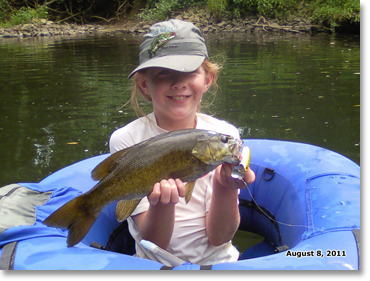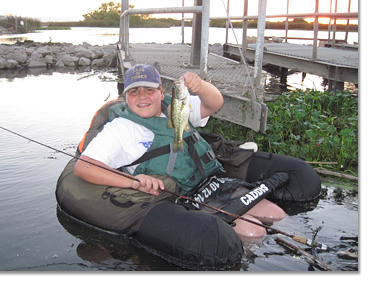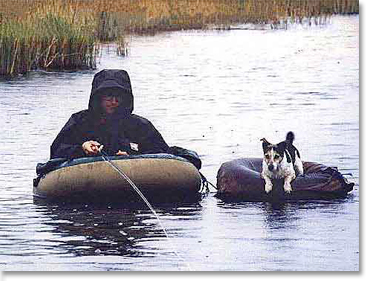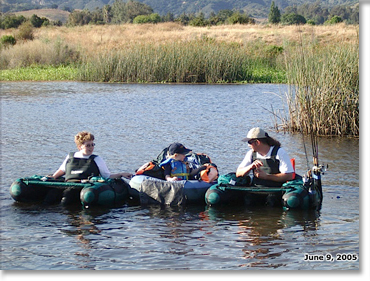|
The Joy of Float Tube Fishing With Kids
"The float tube is a practical, affordable way to bring nature into the lives of urban youth" by Paul Rockwell Lake Del Valle, East Bay Regional Parks, California |
||||||||||||||||||
Eduardo, a spunky 10-year-old from Pittsburg, whose life jacket is a bit too big, is sitting on a float tube on Lake Del Valle, nine miles from Livermore. Gripping a light, fast-action rod, he wants to hook a bluegill, possibly a largemouth bass, and I am sitting on my own belly boat close by. Before we put our rafts on the water at the beach, Eduardo's mother pulled me aside and whispered: "I should tell you that my boy is, well, let me say he is hyperactive. He doesn't do what he is told." I ignore her warning. We are fishing, and I know from experience that, in the quietude of nature, fishing has a calming effect on urban kids who get rare opportunities to escape the anxieties of city life. Eduardo is staring intently at a small bobber drifting by the tules where bluegill feed. He's waiting (with great expectation, I surmise) for some creature from the deep to attack his night crawler that dangles from a hook two feet down. The sun is warm on my neck. It's a gorgeous day in the East Bay hills. Sixteen miles of shoreline, 560 surface acres at the edge of the Ohlone wilderness, Del Valle is surrounded by golden rolling hills carpeted with digger pine and oak. Bald eagles nest in distant trees. Deer amble along the water's edge at dawn. And in the early spring, light mists catching the salmon colors of the rising sun float above the surface like a negligee ruffled in the breeze. It's the absence of urban noise, I think, that makes Del Valle special. Unlike many lakes and waterways adjacent to thruways, Del Valle lies far beyond the constant drone of trucks and the whine of motors. Here the sounds of nature -- ripples of bait fish on the surface, the rustle of bass in the tules, distant calls of Canada geese, the tiny plop of a turtle falling off its log -- all are audible here. Del Valle is one of the brightest jewels in the necklace of lakes managed by the East Bay Regional Park District, and it's the perfect lake for introducing kids to fishing from a float tube. Suddenly Eduardo cries out: "My bobber is gone. What do I do? What do I do?" Sure enough, his little bobber, two feet under the surface, is zooming down the lake like a red sports car peeling rubber. "Set the hook," I say. He doesn't understand. "Tighten the line, and reel it in." I am getting excited myself. "I feel it!" says Eduardo. "Don't let go of the rod, man." I know how kids in shock sometimes drop whole rigs in the water, and he is using my expensive Shimano reel. As the fish comes in close to the tube, I yell: "OK, bring him in." Big mistake. He lowers the rod, whips it back, fish and all. The hooked fish flies past his head, then zings past my right ear and lands in the water on the backside of my tube. I'm thinking: "This fishing with kids is downright dangerous." The two-ounce bluegill (that could be an exaggeration) is still on, so I net the monster and put the fish flapping on Eduardo's lap. "I got em, I got em!" he says. He stares at his waterling. Now I always expect a sense of triumph, an ego boost from the first fish. But Eduardo keeps staring at his fish, looking at its shape, studying the green and yellow colors. We know, if not from our own experience, at least from the great poets, that children develop a sense of beauty at a very early age. Eduardo is mesmerized by his fish, and I'm thinking: here is an example of what Rabbi Abraham Heschel calls "radical amazement," a euphoric moment when creation is experienced in some highly evocative way. In an increasingly denatured world, fishing remains "one of the last ways the young learn the mystery and moral complexity of nature," wrote Richard Louv, author of "Last Child in the Woods." The float tube is a practical, affordable way to bring nature into the lives of urban youth -- especially kids who grow up on asphalt, watch video games, text at dinner and go to bed amid sirens in the night. Float tube fishing opportunities abound in our East Bay lakes. Just being on the water on a raft floating in solitude in the middle of a lake at dusk, when ripples reflect the crimson of the setting sun, is a transformative experience for any kid -- and any adult privileged enough to be in the vicinity. Published in In Motion Magazine August 19, 2013 About the author: Paul Rockwell, a Montclair, California resident, is the former children's librarian with the Albany Library. He is parent coordinator of Gone Tubin', a float tube fishing club for youth.
|
||||||||||||||||||
If you have any thoughts on this or would like to contribute to an ongoing discussion in the  What is New? || Affirmative Action || Art Changes || Autonomy: Chiapas - California || Community Images || Education Rights || E-mail, Opinions and Discussion || En español || Essays from Ireland || Global Eyes || Healthcare || Human Rights/Civil Rights || Piri Thomas || Photo of the Week || QA: Interviews || Region || Rural America || Search || Donate || To be notified of new articles || Survey || In Motion Magazine's Store || In Motion Magazine Staff || In Unity Book of Photos || Links Around The World || OneWorld / US || NPC Productions Copyright © 1995-2013 NPC Productions as a compilation. All Rights Reserved. |





